Telesat Bundle
How is Telesat Redefining Space-Based Internet Sales?
Telesat, a pioneer in satellite communications since 1969, is boldly navigating a transformative shift in its sales and marketing strategy. This evolution is fueled by the ambitious Telesat Lightspeed, a Low Earth Orbit (LEO) satellite constellation poised to revolutionize global connectivity. With the Telesat SWOT Analysis in mind, understanding their approach is crucial for anyone invested in the future of space-based internet.
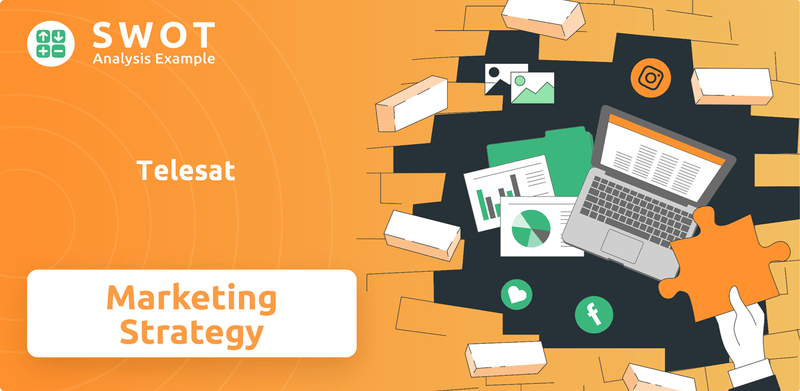
This exploration delves into Telesat's strategic adaptation, examining how the company is tackling the challenges and opportunities within the dynamic satellite communications market. We'll dissect their Telesat sales strategy and marketing strategy, uncovering the tactics used to capture market share and drive growth. Furthermore, we will explore Telesat's business model, its customer acquisition methods, and how it aims to secure its place in a competitive landscape, including its primary and secondary keywords.
How Does Telesat Reach Its Customers?
The sales and marketing strategy of Telesat revolves around a business-to-business (B2B) model, focusing on direct sales and strategic partnerships within the satellite communications market. This approach is critical for the company's growth, particularly with its Lightspeed LEO constellation. Telesat's approach to sales and marketing is designed to leverage existing channels and establish new ones to maximize its reach and impact in the space-based internet sector.
Telesat's core strategy involves partnering with internet connectivity providers, telcos, and other businesses. This method allows Telesat to avoid direct sales to end-users, instead providing a communications backbone. This collaborative approach is a continuation of its successful practices in the Asia-Pacific (APAC) region, where it has worked closely with service providers and satellite operators. The company's focus on partnerships is a key element of its Telesat business model.
The evolution of Telesat's sales channels is highlighted by recent strategic moves. The company is actively engaging in key partnerships to commercialize Lightspeed. For instance, in May 2025, Arabsat signed a Term Sheet for a multi-Gbps capacity pool of Telesat Lightspeed connectivity services, building on a Memorandum of Understanding from March 2024. This agreement aims to integrate Lightspeed into Arabsat's multi-orbit satellite ecosystem for enterprise, telecom, government, and mobility sectors across the Middle East, Africa, Europe, and Central Asia. Another significant partnership announced in March 2025 is with Orange, where a Telesat Lightspeed Landing Station will be hosted at Orange's teleport in France, providing ground segment connectivity. Furthermore, in March 2025, ADN Telecom signed a multi-year partnership agreement to deliver Lightspeed LEO connectivity solutions across Bangladesh and South Asia, leveraging Telesat's Smart Virtual Network Operator capability. In April 2025, Viasat also signed a substantial multi-year contract for Telesat Lightspeed services, integrating Lightspeed into its portfolio for aviation, maritime, enterprise, and defense markets. These partnerships are crucial for Telesat's growth and market share in the LEO segment, with the company expecting its year-end 2025 LEO segment backlog to exceed its year-end 2024 GEO segment backlog of $1.0 billion.
Telesat's sales strategy heavily relies on strategic partnerships to expand its reach and offer its services. These collaborations are essential for distributing its LEO services and reaching diverse markets. The company's ability to secure significant contracts and integrate its services into existing networks is a testament to its effective sales and marketing efforts.
- Arabsat: Signed a Term Sheet in May 2025 for multi-Gbps capacity, integrating Lightspeed into Arabsat's ecosystem.
- Orange: Hosting a Telesat Lightspeed Landing Station in France to provide ground segment connectivity.
- ADN Telecom: A multi-year partnership to deliver Lightspeed LEO solutions across Bangladesh and South Asia.
- Viasat: Signed a multi-year contract to integrate Lightspeed into its portfolio for aviation, maritime, enterprise, and defense markets.
Telesat SWOT Analysis
- Complete SWOT Breakdown
- Fully Customizable
- Editable in Excel & Word
- Professional Formatting
- Investor-Ready Format
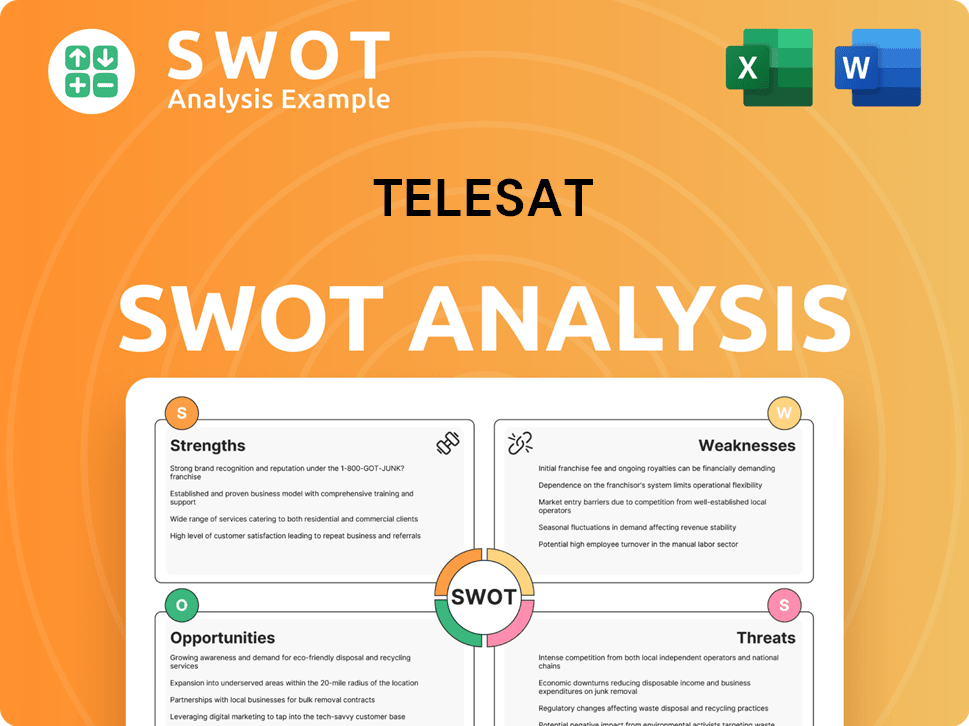
What Marketing Tactics Does Telesat Use?
The marketing tactics employed by the company center on its business-to-business (B2B) model, emphasizing the unique capabilities of its satellite solutions, especially the Telesat Lightspeed constellation. The company focuses on direct engagement with key industries and governments to build awareness and generate leads. The Sales, Marketing, and Business Development Team is responsible for strategic planning, enhancing customer engagement, and identifying new business opportunities.
The company's marketing mix leverages data-driven insights to meet the specific needs of its target sectors, including telecom, government, maritime, and aeronautical customers. This approach highlights guaranteed service levels backed by Service Level Agreements (SLAs), which is a critical differentiator for enterprise-grade networks. Innovations such as network virtualization, machine learning, and AI for network orchestration are key selling points for its advanced capabilities.
Recent announcements and partnerships, like those with Arabsat, Orange, ADN Telecom, and Viasat, are significant marketing efforts, demonstrating market validation and strong interest in Telesat Lightspeed services. These announcements, often made through press releases and industry events, act as powerful testimonials and lead generation tools within their specialized market.
The company's Telesat marketing strategy is primarily B2B, targeting specific industries and governments. This focused approach allows for tailored messaging and direct engagement with key decision-makers.
The Telesat sales strategy heavily promotes the Telesat Lightspeed constellation, emphasizing its advanced capabilities. This includes features like dynamic bandwidth allocation and edge computing integration to attract high-demand customers.
Marketing efforts are informed by data-driven insights to meet the stringent requirements of target sectors. This approach helps in providing solutions for the satellite communications market.
A key differentiator is the emphasis on guaranteed service levels backed by SLAs, critical for enterprise-grade networks. This builds trust and assures reliability for clients.
Strategic partnerships and announcements, such as those with Arabsat and Orange, serve as significant marketing tools. These validate market interest and generate leads.
The company emphasizes MEF 3.0 Layer 2 Carrier Ethernet standards-based connectivity. This feature ensures seamless integration with terrestrial networks, supporting hybrid 5G infrastructures.
The company uses a combination of direct engagement, strategic partnerships, and data-driven insights to promote its services. These tactics are designed to build awareness and generate leads within the B2B market. For more information about the company, you can read a Brief History of Telesat.
- Direct Engagement: Focuses on building relationships with key decision-makers in target industries.
- Strategic Partnerships: Collaborates with other companies to expand its reach and validate its services.
- Data-Driven Insights: Uses data to tailor marketing messages and meet the specific needs of its target sectors.
- Service Level Agreements (SLAs): Guarantees service levels to build trust and assure reliability.
- Technology Focus: Highlights advanced features like network virtualization and AI-driven orchestration.
Telesat PESTLE Analysis
- Covers All 6 PESTLE Categories
- No Research Needed – Save Hours of Work
- Built by Experts, Trusted by Consultants
- Instant Download, Ready to Use
- 100% Editable, Fully Customizable
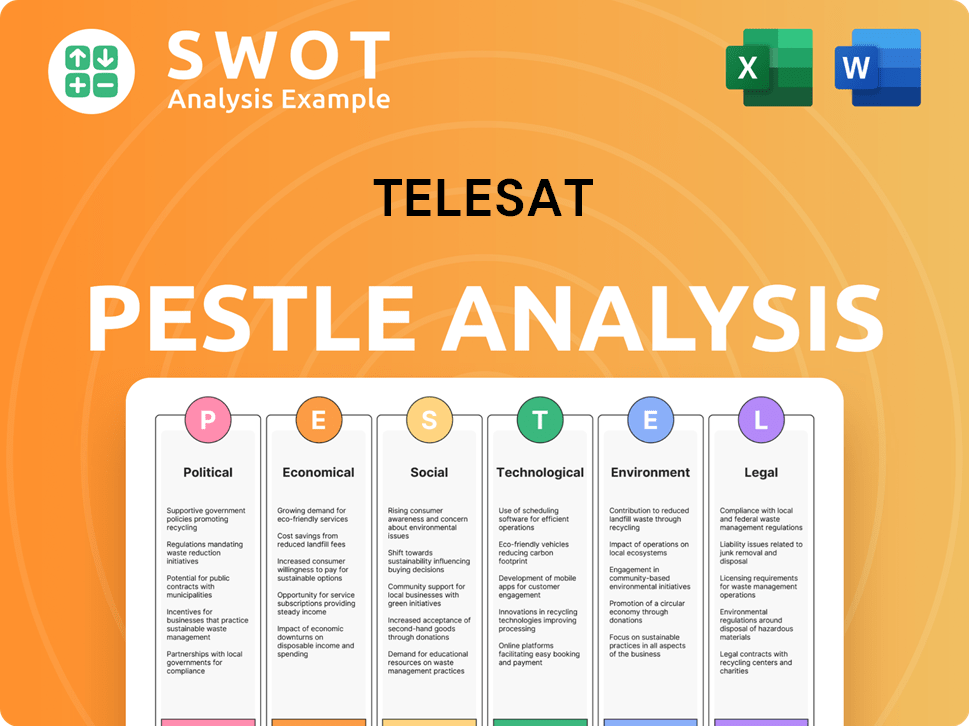
How Is Telesat Positioned in the Market?
The brand positioning of the company centers on its legacy as a global satellite operator, emphasizing over 55 years of engineering excellence and customer-centric service. This long-standing reputation is a key element in its marketing strategy. The core message focuses on delivering critical connectivity solutions to businesses, governments, and communities worldwide. This approach is critical for understanding the company's sales strategy.
The company differentiates itself by targeting the demanding, mission-critical requirements of enterprise and government users, rather than the consumer market. This strategic focus is central to the company's business model. The brand's visual identity and tone of voice likely project professionalism and technical expertise, especially with the introduction of Telesat Lightspeed, its LEO constellation.
The company's approach involves working through existing service providers and equipment manufacturers. This strategy allows the company to offer integrated solutions, emphasizing innovation, high performance, and robust security, including over 400 cybersecurity controls for Lightspeed. This is key to understanding how the company acquires customers.
The company's core message revolves around delivering critical connectivity solutions. It targets businesses, governments, and communities globally. This is a key component of the Telesat marketing strategy.
The company's target market includes enterprise and government users with mission-critical needs. This contrasts with consumer-focused competitors. This focus impacts the company's sales and marketing challenges.
The company differentiates itself by focusing on enterprise-grade solutions. This involves higher performance and robust security features. This is a key Telesat's competitive advantages in sales.
The company has strategic partnerships with major players like Viasat, Orange, and Arabsat. These partnerships support its reputable standing in the satellite communications market. This is crucial for Telesat's partnerships for sales and marketing.
The company's brand is built on engineering excellence, reliability, and customer service. This is reflected in the company's approach to the Space-based internet. The company's ongoing investment in Lightspeed, with capital expenditures for 2025 projected between $900 million and $1.1 billion, further reinforces its commitment to innovation and future market leadership.
- Innovation: The company emphasizes innovation, especially with its LEO constellation.
- Performance: High performance, including low latency and high capacity, is a key selling point.
- Security: The company prioritizes robust security, including over 400 cybersecurity controls.
- Fiber-like Speeds: The company promotes fiber-like speeds and global coverage.
Telesat Business Model Canvas
- Complete 9-Block Business Model Canvas
- Effortlessly Communicate Your Business Strategy
- Investor-Ready BMC Format
- 100% Editable and Customizable
- Clear and Structured Layout
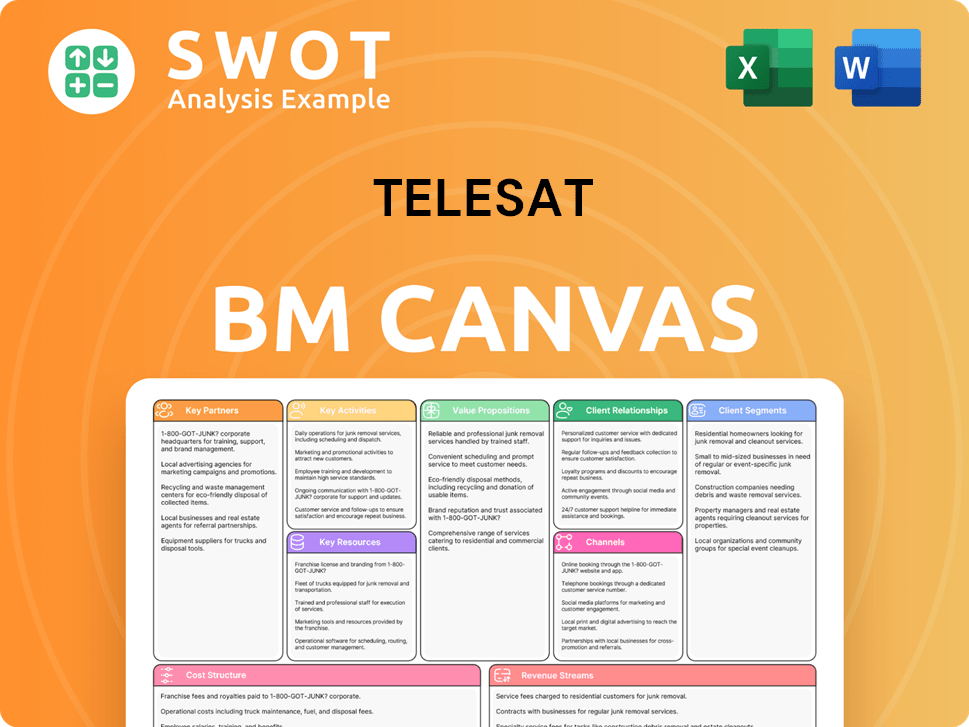
What Are Telesat’s Most Notable Campaigns?
The core of the company's current Telesat sales strategy and Telesat marketing strategy revolves around the Telesat Lightspeed Low Earth Orbit (LEO) satellite constellation. This ambitious project is the primary focus of recent sales and marketing efforts, with the main goals being to secure pre-launch commitments and establish a strong market presence for its LEO services. The Telesat business model is heavily reliant on the successful deployment and commercialization of Lightspeed.
A significant milestone for this 'campaign' was the securing of $2.54 billion in loan financing from the Canadian and Quebec governments in September 2024. This funding was crucial, fully supporting Lightspeed through its deployment phase. This financial backing underscored governmental confidence in the project's potential for investment, job creation, and bridging the digital divide, especially in the Arctic. The success of these campaigns is measured by significant contractual commitments, indicating strong market response and customer interest in the Telesat Lightspeed offering. For more detailed information on the target market, see Target Market of Telesat.
These partnerships, announced through press releases and industry events, are aimed at building a strong LEO backlog. As of March 31, 2025, Telesat's LEO backlog was nearly $1.1 billion. The company anticipates that the year-end 2025 LEO segment backlog will exceed the year-end 2024 GEO segment backlog of $1.0 billion.
Telesat signed a multi-year contract with Viasat for Lightspeed services. Viasat, a leading broadband connectivity provider in commercial aviation, plans to integrate Lightspeed into its services portfolio for aviation, maritime, enterprise, and defense markets. This collaboration highlights the capabilities of Lightspeed for high-demand mobility and enterprise applications.
Building on a March 2024 MoU, Arabsat selected Telesat Lightspeed LEO services for its multi-orbit connectivity portfolio, signing a Term Sheet for a multi-Gbps capacity pool. This partnership positions Lightspeed to serve enterprise, telecom, government, and mobility sectors across the Middle East, Africa, Europe, and Central Asia.
Orange and Telesat signed a multi-year partnership for Lightspeed LEO satellite connectivity, with Orange hosting a Lightspeed Landing Station at its teleport in France. This collaboration strengthens Orange's ability to meet customer needs in underserved regions and enhances global digital infrastructure resilience.
ADN Telecom signed a multi-year agreement to deliver Lightspeed LEO connectivity solutions across Bangladesh and South Asia, leveraging Telesat's Smart Virtual Network Operator capability for enterprise, maritime, and government customers.
Telesat Porter's Five Forces Analysis
- Covers All 5 Competitive Forces in Detail
- Structured for Consultants, Students, and Founders
- 100% Editable in Microsoft Word & Excel
- Instant Digital Download – Use Immediately
- Compatible with Mac & PC – Fully Unlocked
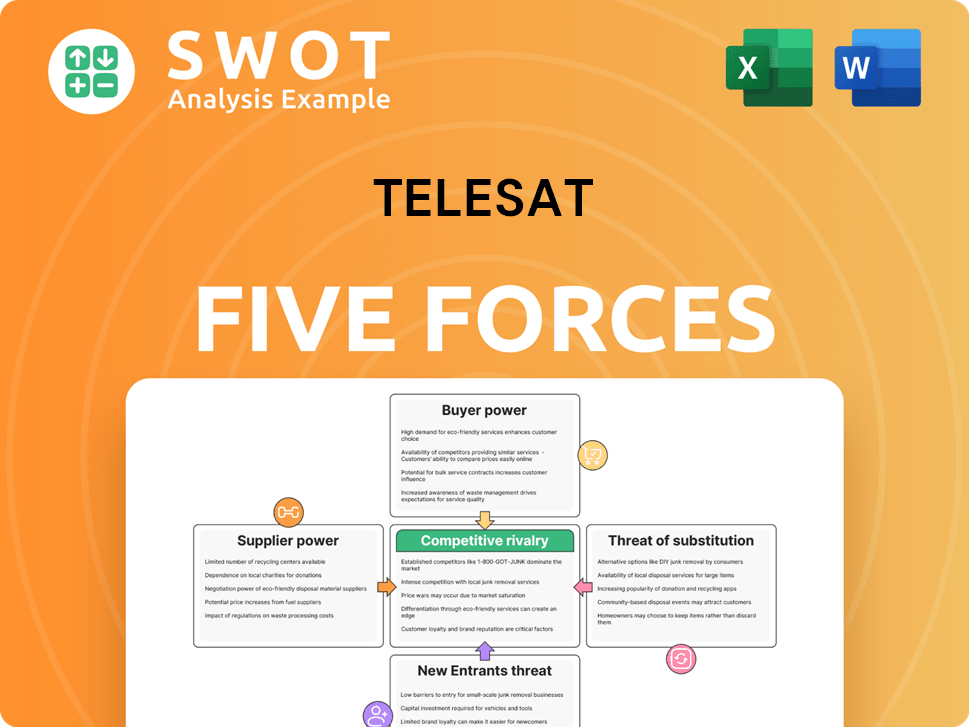
Related Blogs
- What are Mission Vision & Core Values of Telesat Company?
- What is Competitive Landscape of Telesat Company?
- What is Growth Strategy and Future Prospects of Telesat Company?
- How Does Telesat Company Work?
- What is Brief History of Telesat Company?
- Who Owns Telesat Company?
- What is Customer Demographics and Target Market of Telesat Company?
Disclaimer
All information, articles, and product details provided on this website are for general informational and educational purposes only. We do not claim any ownership over, nor do we intend to infringe upon, any trademarks, copyrights, logos, brand names, or other intellectual property mentioned or depicted on this site. Such intellectual property remains the property of its respective owners, and any references here are made solely for identification or informational purposes, without implying any affiliation, endorsement, or partnership.
We make no representations or warranties, express or implied, regarding the accuracy, completeness, or suitability of any content or products presented. Nothing on this website should be construed as legal, tax, investment, financial, medical, or other professional advice. In addition, no part of this site—including articles or product references—constitutes a solicitation, recommendation, endorsement, advertisement, or offer to buy or sell any securities, franchises, or other financial instruments, particularly in jurisdictions where such activity would be unlawful.
All content is of a general nature and may not address the specific circumstances of any individual or entity. It is not a substitute for professional advice or services. Any actions you take based on the information provided here are strictly at your own risk. You accept full responsibility for any decisions or outcomes arising from your use of this website and agree to release us from any liability in connection with your use of, or reliance upon, the content or products found herein.